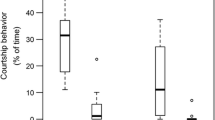Abstract
Courtship varies among individuals, partly because individuals differ in quality. To explore proximate factors affecting courtship behavior, I investigated the effect of diet quality on mate choice and competition in the barklouseLepinotus patruelis Pearman (Psocoptera: Trogiidae) in the laboratory. The effect of sex ratio on mate choice was also addressed. Some males were found to exhibit active mate choice, and rejected females in both male- and female-biased sex ratio groups, although they were more likely to do so in a female-biased sex ratio group. Diet quality affected male mate choice: males on high-quality diets were significantly more likely to reject females than males on low-quality diets. Males exhibited choice significantly more often than females, who showed no overt signs of choosiness. Both males and females competed for, access to mates: both sexes attempted to interfere with mounted pairs and females grappled. The choosiness of the male may have directly affected the incidence of female competition. The results also suggest that the patterns of mate choice inL. patruelis differ from those expected by conventional sex role theory.
Similar content being viewed by others
References
Beani, L. and Turillazzi, S. (1988). Alternative mating tactics in males ofPolistes dominulus (Hymenoptera, Vespidae).Behav. Ecol. Sociobiol. 22: 257–264.
Carroll, S. P., and Corneli, P. S. (1995). Divergence in male mating tactics between 2 populations of the soapberry bug. 2. Genetic change and the evolution of a plastic reaction norm in a variable social-environment.Behav. Ecol. 6: 46–56.
Clutton-Brock, T. H., and Parker, G. A. (1992). Potential reproductive rates and the operation of sexual selection.Q. Rev. Biol. 67: 437–456.
Fahy, E. D. (1971). Some factors in the ecology and dispersal ofLepinotus patruelis Pearman (Psocoptera), a pest of stored products.J. Stored Prod. Res. 7: 107–123.
Foote, C. J. (1988). Male mate choice dependent on male size in salmon.Behavior 106: 63–80.
Fox C. W. (1993). Multiple mating, lifetime fecundity, and female mortality of the bruchid beetle,Callosobruchus maculatus (Coleoptera; Bruchidae).Funct. Ecol. 7: 203–208.
Gwynne, D. T. (1981). Sexual difference theory: Mormon crickets show reversal in mate choice.Science 213: 779–780.
Gwynne, D. T. (1984). Courtship feeding increases female reproductive success in bushcrickets.Nature 307: 361–363.
Gwynne, D. T. (1990). Testing parental investment and the control of sexual selection in the katydids: The operational sex ratio.Am. Nat. 136: 474–484.
Gwynne, D. T. (1991). Sexual competition among females: What causes courtship-role reversal?Trends Ecol. Evol. 6: 118–121.
Gwynne, D. T., and Simmons, L. W. (1990). Experimental reversal of courtship roles in an insect.Nature 346: 172–174.
Johnson, L. K., and Hubbell, S. P. (1984). Male choice: Experimental demonstration in a brentid weevil.Behav. Ecol. Sociobiol. 15: 183–188.
Kempton, R. A., Lowe, H. J. B., and Bintcliffe, E. J. B. (1980). The relationship between fecundity and adult weight inMyzus persicae.J. Anim. Ecol. 49: 917–926.
Lawlor, B. J., Read, A. F., Keymer, A. E., Parveen, G., and Crompton, D. W. T. (1990). Nonrandom mating in a parasitic worm: Mate choice by males?Anim. Behav. 40: 870–876.
Lawrence, W. S. (1986). Male choice and competition inTetraopes tetraophthalmus: Effects of local sex ratio variation.Behav. Ecol. Sociol. 18: 289–296.
Oneill, K. M., and Evans, H. E. (1983). Body size and alternative mating tactics in the beewolfPhilanthus zebratus (Hymenoptera, Sphecidae).Biol. J Linn. Soc. 20: 175–184.
Owens, I. P. F., Burke, T., and Thompson, D. B. A. (1994). Extraordinary sex roles in the Eurasian dotterel: Female mating arena, female-female competition, and female mate choice.Am. Nat. 144: 76–100.
Parker, G. A. (1983). Mate quality and mating decisions. In Bateson, P. (ed.),Mate Choice, Cambridge University Press, Cambridge, pp. 141–146.
Pearman, J. V. (1928). On sound production in the Psocoptera and on a presumed stridulatory organ.Entomol. Mon. Mag. 64: 179–187.
Rasmussen, J. L. (1994). The influence of horn and body-size on the reproductive-behavior of the horned rainbow scarab beetlePhanaeus difformis (Coleoptera, Scarabaeidae).J. Insect Behav. 7: 67–82.
Shatral, A. (1993). Diet influences male-female interactions in the bushcricketRequena verticalis (Orthoptera: Tettigoniidae).J. Insect Behav. 6: 379–388.
Shuster, S. M. (1981). Sexual selection in the Socorro isopodThermosphaeroma thermophilium (Cole) (Crustacea: Pericarida).Anim. Behav. 29: 698–707.
Simmons, L. W., and Bailey, W. J. (1990). Resource influenced sex roles of zaprochiline Tettigoniids (Orthoptera: Tettigoniidae).Evolution 44: 1853–1868.
Svensson, B. G., and Petersson E. (1987). Sex-role reversed courtship behavior, sexual dimorphism and nuptial gifts in the dance fly,Empis borealis (L.).Ann. Zool. Fennici 24: 323–334.
Telford, S. R., and Dangerfield, J. M. (1994). Males control the duration of copulation in the tropical millipedeAlloporus uncinatus (Diplopoda, Julida).S. A. J. Zool. 29: 266–268.
Vincent, V., Ahnesjö I., Berglund, A., and Rosenqvist, G. (1992). Pipefishes and seahorses: Are they all sex role reversed?Trends Ecol. Evol. 7: 237–241.
Yasui, Y. (1994). Adaptive-control of copulation duration by males under sperm competition in the mite,Macrocheles muscaedomesticae.Exp. Appl. Acarol. 18: 543–554.
Wearing-Wilde, J. M. (1995a). The reproductive biology ofLepinotus patruelis (Psocoptera): Implications for courtship theory. DPhil dissertation, University of Oxford.
Wearing-Wilde, J. M. (1995b). The sclerotized spermatophore of the barklouseLepinotus patruelis.Tissue Cell 27: 447–456.
Author information
Authors and Affiliations
Rights and permissions
About this article
Cite this article
Wearing-Wilde, J. Mate choice and competition in the barklouseLepinotus patruelis (Psocoptera: Trogiidae): The effect of diet quality and sex ratio. J Insect Behav 9, 599–612 (1996). https://doi.org/10.1007/BF02213883
Revised:
Issue Date:
DOI: https://doi.org/10.1007/BF02213883




